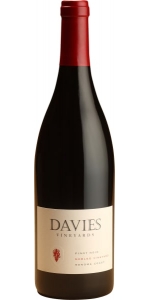Wine from J Davies
The first planting on what is now the J. Davies Estate Vineyard was in 1862 by Jacob Schram, representing the Napa Valley’s first hillside vineyard. This and the J. Davies Estate McEachran Vineyard are the southern most vineyards in the Diamond Mountain District AVA. Flanked by two cool creek canyons, Nash Creek to the north and Ritchie Creek to the south, and surrounded by dense coniferous and deciduous forests, these vines produce late-ripening, richly-concentrated fruit.
Initially, the Davies planted their estate vineyards to the traditional Method Champenoise grape varieties in 1965. But over time it became apparent that this land was better suited to the cultivation of red Bordeaux varietals.
Today, expanding from the knowledge gained through the production of the J. Davies Estate Cabernet Sauvignon from Diamond Mountain, our collection of Cabernet Sauvignon is an exploration of new Napa Valley vineyard sites. Each vineyard site provides the winemaking team unique flavor characteristics from the varietal, allowing them the opportunity to produce a wine that is strikingly different than the J. Davies Estate wine while still delicious and singular to the vineyard or appellation from which it came.
Developing upon this passion, history and experience, second-generation vintner Hugh Davies and winemaker Sean Thompson also craft vineyard and appellation designated Pinot Noirs. The family’s experience with Pinot Noir dates back to 1967, when Jack and Jamie Davies first used this elegant red varietal to make their inaugural vintage of Blanc de Noirs sparkling wine. Over the 45 years following its first use, Schramsberg’s winemakers have built long-lasting relationships with some of the North Coast’s best Pinot Noir growers.
J. Davies Nobles Vineyard Pinot Noir is made from 100 percent Pinot Noir.
The Nobles Pinot Noir starts off with aromas of rich strawberry, black cherry and Earl Grey tea, followed gracefully with coriander and exotic spices. The palate offers a juicy mid-palate of blueberry and plum layered with mocha and rhubarb, closing with a long-integrated acidity.
Review:
Elegant and pure-tasting, with red berry, plum and raspberry flavors that are well-structured. Toasty midpalate, with a rich finish that offers spicy minerality. Drink now through 2026.
-Wine Spectator 92 Points
J. Davies Nobles Vineyard Pinot Noir is made from 100 percent Pinot Noir.
The 2020 Nobles Vineyard Pinot Noir’s aroma elegantly opens with blueberry compote, dark cherry and dried citrus peels, followed with a touch of baking spice and a hint of forest floor. The palate’s bright entry leads to notes of cranberry, red raspberry and a sprinkle of black tea, while a crisp acidity supports silky tannins to a clean finish.
Review:
Bountiful black-cherry flavors and good balance make this full-bodied wine difficult to resist. Black-fruit flavors are rich and well concentrated, backed by a light touch on the oak spices that emerge on the finish and add nice complexity.
-Wine Enthusiast 93 Points
This carries the forest green scent of the far-coast hills, a savory pinot noir with mineral intensity. The wine’s cherry-red fruit ripens on the eastern, leeward slopes of the second ridge in from the Pacific, that ripeness tamed by an earthy evergreen scent lasts for minutes, as if breathing the air at the edge of a redwood grove.
-Wine & Spirits 93 Points
- back
Selected Options
Wineries
Categories
Pricing
Countries
Regions
Grape Types
Wineries
Organic/Free Shipping
All older vintage wines have been purchased from a single collectors cellar. Pictures can be requested before shipment.
Maison Le Bihan Sancerre Blanc is 100% Sauvignon Blanc.
Pale, lemon green color, with pronounced citrus intensity. The nose is dominated by lychee, grapefruit and peach aromas; rich and well-rounded in the mouth, showing a pleasant acidity length.
Traditional, in stainless steel tanks. Bladder press grape pressing and reception of the must in the tanks by gravity. Settling of the must 24-36 hours before fermentation. Slow alcoholic fermentation only is done, in order to preserve the aromatic qualities. A racking is done over 3 months later. Clarification and light filtration before bottling at the estate.
To drink as an Aperitif or with food, such as white meat, seafood, crottin de Chavignol goat cheese.





